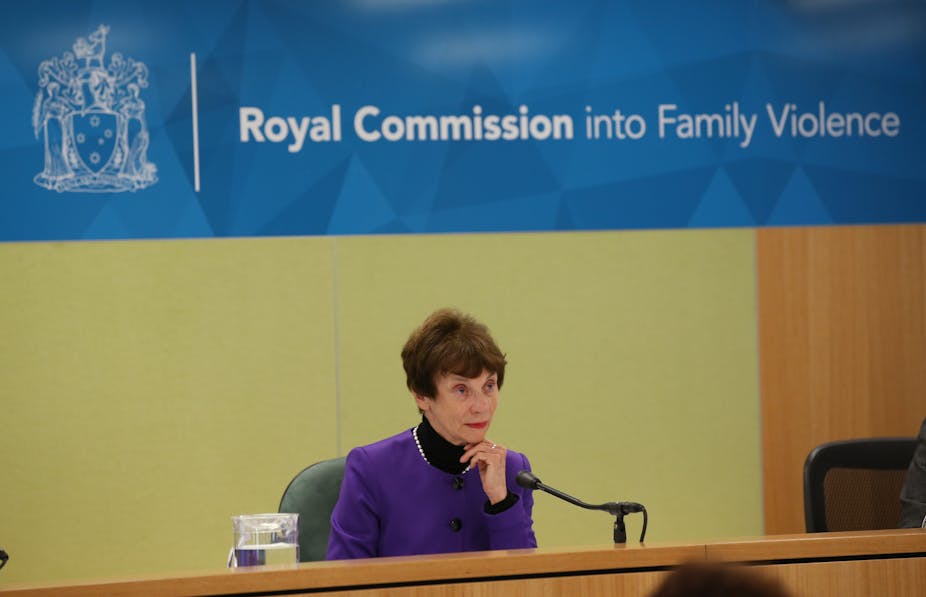Today marks one year since Victoria’s Royal Commission into Family Violence released its seven-volume report and recommendations. These set out a blueprint to transform responses to, and prevention of, family violence.
A year on, Victoria continues to lead the nation in these areas. It is also arguably emerging as a world leader.
Successes so far
The commission made 227 recommendations to transform Victoria’s family violence system. These were based on evidence gathered from 1,000 written submissions, 44 group sessions and 25 days of public hearings with 220 witnesses.
On the same day as the commission released its report, Victorian Premier Daniel Andrews committed his government to implementing all of the recommendations.
In April 2016 the government committed A$572 million over the next two years tied specifically to ensuring the completion of 65 recommendations. To date, according to the government’s own tracker, ten recommendations have been completed, 212 are in progress and five have not yet been started.
Several of those completed relate to setting up a “sustainable and certain” governance structure to guide the reform process. This included establishing a family violence unit within the Department of Premier and Cabinet, a statewide family violence advisory committee, and convening an expert committee on perpetrator interventions.
This governance structure is unique to Victoria. It highlights the government’s ongoing commitment to consultation and stakeholder engagement in delivering on the commission’s work.
Recommendations yet to be started include for the Melbourne Children’s Court to establish family violence applicant and respondent worker positions, and to ensure police referral forms capture disability data.
Among the list of reforms under way but yet to be completed is the complex task of designing, developing and implementing what the commission referred to as “support and safety hubs”.
In recognition of the value of multi-agency responses to family violence, the commission’s idea of statewide hubs seeks to ensure those experiencing – and potentially perpetrating – family violence have access to an integrated range of services in one place. The government’s ten-year plan begins to detail the initial thinking that will inform this reform’s delivery.
Once implemented, the hubs – an Australian first – will provide valuable lessons for other states and territories seeking to introduce integrated responses to family violence.
Ongoing challenges
The Victorian government should be commended for its commitment to delivering the royal commission’s recommendations. But challenges remain.
In particular, the hardline response to recent concerns relating to homeless people in the Melbourne CBD fails to recognise the long-established link between family violence victimisation and homelessness. Between 2013 and 2014, family violence was cited as the main reason people sought help from specialist homelessness services in Victoria.
As the commission documents, people experiencing family violence are at increased risk of homelessness due to several factors. These include the absence of a safe home environment, the shortage of affordable housing options, and the saturated private rental market.
While Andrews has said Victorian women will not be forced to choose between safety and the streets, the Melbourne City Council vote to ban camping in the city will undoubtedly exacerbate difficulties for women experiencing homelessness due to family violence. It also contributes to a public response to homelessness that is devoid of understanding and compassion.
An integrated response to family violence must not ignore the link between these two issues. Improving Victoria’s family violence system requires better responses to homelessness above and beyond the reforms required as part of the commission’s agenda.
The federal barrier
Federally, the barriers to reform, and the lack of a national commitment to funding related Commonwealth services, continue to pose significant challenges.
More than 20 of the royal commission’s recommendations rely on either Commonwealth co-operation or federal law reform. These include broadening the definition of family violence in the Migration Regulations and pursuing amendments to the Family Law Act.
The federal government’s move away from delivering on the recommendation to expand resourcing for legal services in family violence matters is particularly concerning.
In April 2016, the Victorian government committed interim funding of $4.6 million to support legal assistance services. But the federal government has continued to forecast significant cuts to the legal services relied upon by women and children experiencing and escaping family violence.
The recently announced federal parliamentary inquiry into family law is an important acknowledgement of the need to tackle this area. But reform will have to be supported by resources, too.
Without immediate and sustained action federally, much of the work done to improve legal responses to family violence in Victoria will fail to secure better outcomes for women and children. They will be unable to access justice, fail to secure legal representation, and forced to navigate a significantly under-resourced and over-burdened family law system.
Being bold for change
International Women’s Day this year urged us to be “bold for change”.
The royal commission, and its recommendations, set out a bold vision for change. The challenge one year on is to ensure its bold vision is matched by bold action.
There are signs of bold action on family violence. But the momentum must be maintained in Victoria – and the federal government needs to get on board.
The National Sexual Assault, Family & Domestic Violence Counselling Line – 1800 RESPECT (1800 737 732) – is available 24 hours a day, seven days a week for any Australian who has experienced, or is at risk of, family and domestic violence and/or sexual assault.

